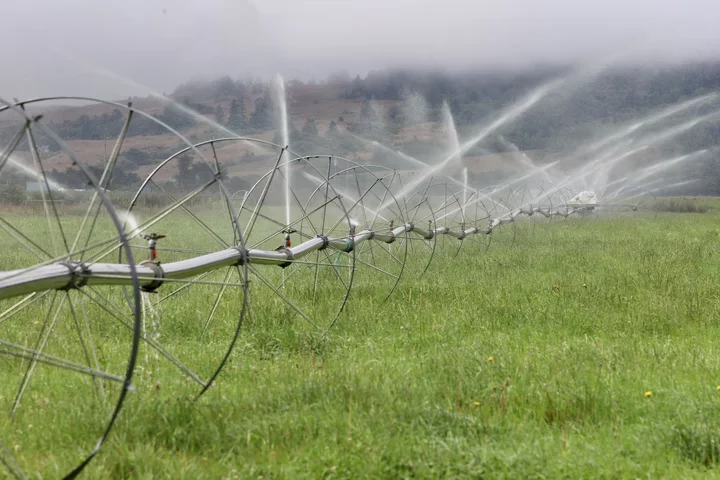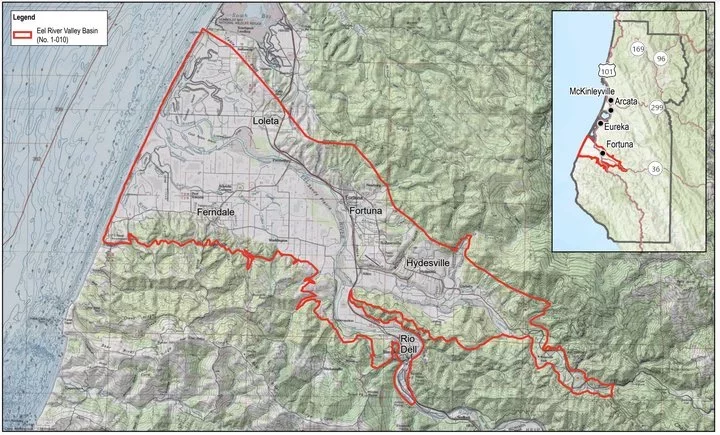Agricultural land in the fertile Eel River Valley gets irrigated during dry months via wells that draw from the alluvial aquifer. | File photo by Andrew Goff.
PREVIOUSLY
- Lawsuit Could Force Humboldt County to Regulate Groundwater Pumping in the Eel River Valley
- Friends of the Eel River Sues County for Failure to Protect Public Trust by Regulating Groundwater Extractions in Lower Eel
- County Staff Present Groundwater Sustainability Plan for Eel River Valley
###
We somehow missed this decision when it was handed down late last month, but Humboldt County Superior Court Presiding Judge Kelly Neel ruled against local nonprofit Friends of the Eel River (FOER) in its lawsuit concerning the county’s management of groundwater extraction in the Eel River Valley.
The lawsuit, first filed in 2022, argued that Humboldt County was falling short of its responsibility to protect public trust resources in the Eel by failing to consider the adverse effects of groundwater pumping, particularly during the late summer and early fall.
FOER’s suit pointed to instances of extremely low flows and the resulting inhospitable environmental conditions for migrating salmon, conditions such as anemic flow, warm temperatures, algal accretion and low dissolved oxygen. Citing the public trust doctrine, a common law principle that dates to ancient Rome, the suit asked the court to require Humboldt County to create a program to regulate groundwater pumping.
But Judge Neel instead found that the county is already considering public trust resources on the Eel through both its Groundwater Sustainability Plan and its well permitting process. FOER may not like way the county is exercising its discretion, Neel’s decision says, but “Petitioners cannot seek declaratory relief to use the Court to tell Respondents how to do their job.”
The county has to consider many factors when weighing public trust resources on the Eel, factors such as navigation, commerce, fishing, the right to hunt, bathe, or swim, scientific study, open space availability, animal habitat, natural beauty, agricultural need, and human consumption. “Balancing these factors and selecting a course of action is the essence of discretion,” Neel’s ruling says.
Because the county is exercising that discretion, she found, FOER is not entitled to a writ of mandamus, a type of court order that’s typically considered a last resort when no other remedy is available.
In a prepared statement sent to the Outpost, FOER said Neel’s decision “appears to misinterpret the nature of the public trust doctrine and FOER’s argument.”
The nonprofit’s lawsuit pointed out that the county has only analyzed the impacts of groundwater use on Chinook when flows in the Eel are above 130 cubic feet per second (cfs) and argued that the public trust doctrine requires the county to analyze such impacts throughout each season.
“The fact remains that groundwater pumping in the Lower Eel depletes surface flows by as much as 15 cubic feet per second (cfs), and that during dry summers, flows in the Lower Eel often dip as low as 50cfs,” the statement reads. “Unfortunately, irrigators in the Lower Eel will remain some of the only water users in the entire County who are not required to do their part and reduce water use during dry times.”
The statement adds, “We are disappointed by the ruling and considering our options.”
Hank Seemann, the county’s deputy director of environmental services, also didn’t learn about Neel’s decision until last week. County staff had declined to comment on the case while it was still in court, but on Thursday Seemann described the suit as “misdirected and also wasteful.” He said the case was based on “a pretty extraordinary claim,” and it diverted “enormous amounts of money and staff time” away from other important projects.
Map of the Eel River Groundwater Basin. | Image via County of Humboldt.
###
With help from a $2 million state grant, the county spent years developing its Eel River Valley Groundwater Sustainability Plan, as required by the Sustainable Groundwater Management Act of 2014.
“We did a lot of technical work and data collection and stakeholder engagement and computer modeling to try to understand the dynamics of how groundwater is used and how it affects different things like seawater intrusion, but also the interconnected flows and streams,” Seemann said in a phone interview yesterday.
The county conducts ongoing monitoring per the terms of that plan, an updated version of which will be coming in about a year and a half, according to Seemann.
Meanwhile, the county is also required to weigh potential impacts to public trust resources whenever it considers issuing a new permit for groundwater extraction.
The claim Seemann found extraordinary was that under the public trust doctrine, a judge needed to order the county to develop a program to regulate all existing wells, or at least wells that would were negatively impacting public trust resources on the Eel.
“The judge concluded that the county has discretion to implement the public trust doctrine, and she saw that the administrative record indicated that, yes, the county had done that … ,” Seemann said. “The judge determined that their legal basis didn’t hold water.”
He lamented that FOER chose an “adversarial approach” because the courtroom setting didn’t allow other stakeholders to weigh in and because such legal proceedings aren’t conducive to thoughtful consideration of complicated scientific information like hydrologic computer modeling results.
Seemann estimated that the suit cost the county a couple hundred thousand dollars and postponed work on projects including restoration work on Ryan Creek, a sand-bearing stream that flows through the McKay Community forest and empties into Humboldt Bay.
“It might be a very beneficial project, and it’s ready to move the next phase, but we had to put it on hold,” Seemann said. “We just had to divert time to this case. So I think that was really unfortunate.”
FOER is disappointed, too, albeit for different reasons.
“While cannabis cultivators, domestic users, and appropriative water rights holders are subject to curtailments when flows are low (and much stronger regulations in the case of cannabis cultivators), those taking surface flows via groundwater can pump as they like regardless of the impact … ,” the group’s statement says. “The question remains why the County did not analyze impacts of groundwater extraction continuously throughout each season, as is required by the public trust doctrine.”
Seemann said the county did the county’s computer modeling was based on the best available data and scientific information and that staff “applied it the best we could” given the limitations and uncertainties of such models.
He also noted that there are “some exciting innovations going on” in irrigation management, citing Vevoda Dairy’s use of soil moisture sensors and saying such technology will help reduce groundwater extraction.
Seemann maintained that FOER’s attorney didn’t provide compelling and overwhelming evidence that existing wells are causing harm to public trust resources at such a magnitude that the county must intervene.
Judge Neel agreed. You can read her full decision below.
###
DOCUMENT: Judge Neel’s Ruling and Order


CLICK TO MANAGE